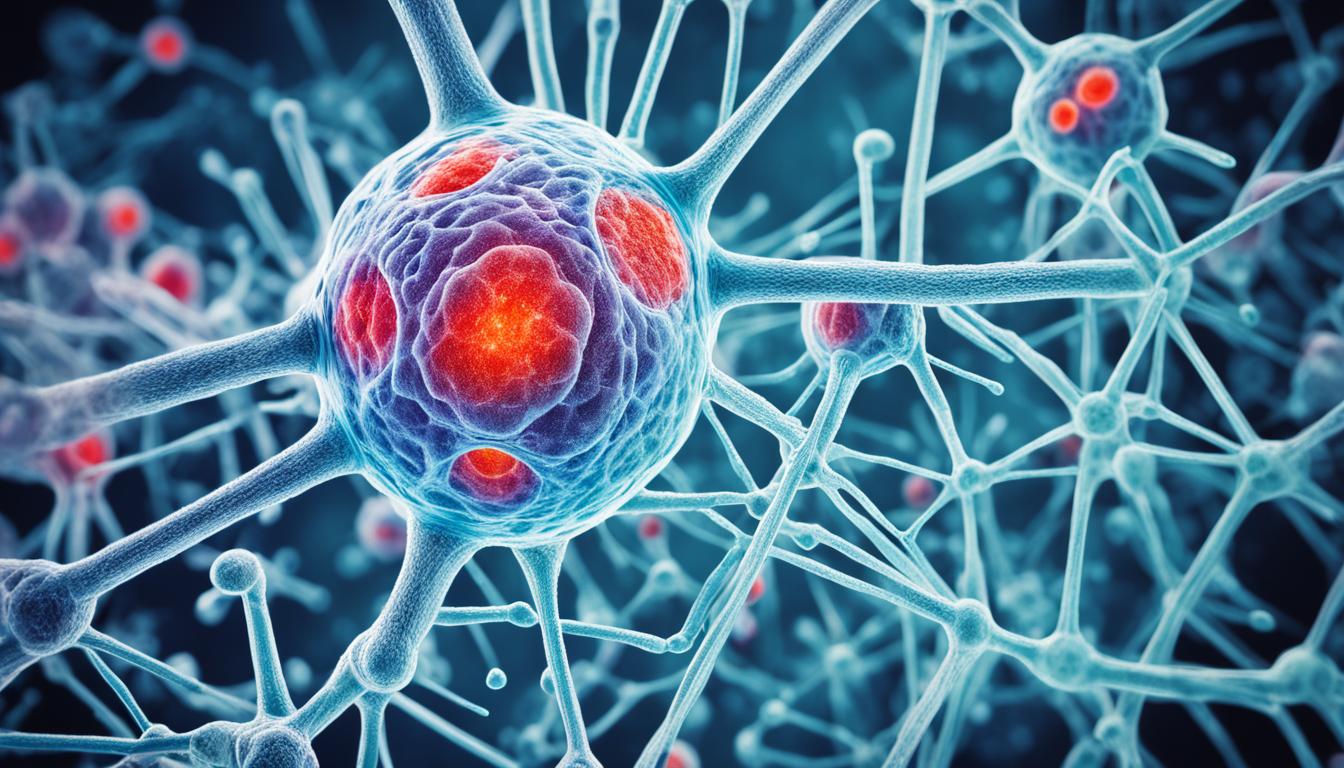X-linked agammaglobulinemia (XLA) is an immune disorder passed down by genetics. It’s caused by a problem in the Bruton’s tyrosine kinase (BTK) gene. This issue makes B cells not grow well, which means people have low or no immune antibodies. The disease often shows up in boys early, around 2.5 years old.
Kids with XLA often get sick with throat and ear problems, and lung infections. They might need strong antibiotics through a vein to get better. XLA makes these kids very likely to catch infections from certain bacteria and viruses. They also often have long-lasting diarrhea.
At the moment, XLA can’t be cured. Yet, getting immune antibodies regularly and using strong medicines help a lot. Also, doctors are looking at how stem cell treatment might help in the future.
Key Takeaways:
- X-linked agammaglobulinemia (XLA) is a primary immunodeficiency disorder caused by a mutation in the Bruton’s tyrosine kinase (BTK) gene.
- Common symptoms of XLA include recurrent upper respiratory tract infections and pneumonia.
- XLA patients are susceptible to infections from bacteria and viruses, as well as chronic diarrhea.
- Lifelong immunoglobulin replacement therapy and antibiotics are used to prevent and treat infections in XLA.
- Stem cell therapy is an emerging treatment option being explored for XLA.
Etiology and Pathophysiology of X-Linked Agammaglobulinemia
X-linked agammaglobulinemia (XLA) is a disorder that affects the immune system. It is caused by changes in the BTK gene. This gene helps B cells to grow.
When the BTK gene is not working right, B cells don’t mature. This means the body doesn’t make enough antibodies. Without enough antibodies, the immune system can’t protect the body well.
This disorder mainly affects males. But, some rare cases show it can affect both boys and girls. In these cases, different gene mutations are to blame. These mutations stop B cells from growing properly, just like in XLA.
Scientists have learned a lot about XLA. But, they are still trying to understand fully how these gene mutations cause the disease.
Comparison of XLA and ARA
| XLA | ARA |
|---|---|
| Primary cause: BTK gene mutation | Primary cause: Mutations in genes involved in B cell maturation and function |
| X-linked disorder affecting males almost exclusively | Rare autosomal recessive disorder |
| Disruption of B cell development and lack of immunoglobulin production | Similar clinical phenotype to XLA |
Pathogenesis of XLA
The pathogenesis of XLA involves faulty B cell formation due to BTK gene problems. Without normal B cells, the body can’t fight infections well. This weakens the immune system.
BTK is a type of tyrosine kinase important for B cell health. When the BTK gene is mutated, it disrupts important signals for B cell growth and function. This leads to an ineffective immune system.
Knowing how XLA happens is key to finding better treatments. It could help improve life for those with the disorder.
Diagnosis and Management of X-Linked Agammaglobulinemia
People with X-linked agammaglobulinemia (XLA) often get sick, needing hospital care for bacterial pneumonia. They need strong antibiotics to get better. Doctors confirm XLA by testing the person’s blood. They check levels of different antibodies, which are proteins that help fight diseases. In XLA patients, these protein levels are low or missing. Also, their bodies don’t make a strong response to vaccines. A special test called lymphocyte phenotyping, done with a machine called flow cytometry, can help confirm the low levels of certain blood cells.
After a diagnosis, a person with XLA needs lifelong treatment. They get regular infusions of immunoglobulins, the missing antibodies. This boosts their immune system.
Recently, stem cell therapy has caught the eye as a possible treatment for XLA. It involves putting healthy stem cells into the patient. This could restore their ability to fight diseases. But, this method is not fully understood yet. Scientists are still checking to see how safe and helpful it is in the long run.
The journey with XLA starts with many tests to confirm the problem. Then, it’s all about regularly getting the missing antibodies to stay healthy. Stem cell therapy also shines as a hope for the future.

